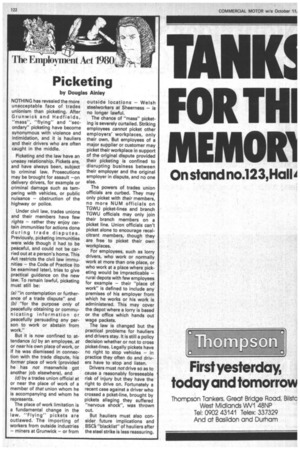Picketing
Page 124

If you've noticed an error in this article please click here to report it so we can fix it.
by Douglas Ainley NOTHING has revealed the more unacceptable face of trades unionism than picketing. After Grunwick and Hadfields, "mass", "flying" and "secondary" picketing have become synonymous with violence and intimidation, and it is hauliers and their drivers who are often caught in the middle.
Picketing and the law have an uneasy relationship. Pickets are, and have always been, subject to criminal law. Prosecutions may be brought for assault —on delivery drivers, for example or criminal damage such as tampering with vehicles, or public nuisance — obstruction of the highway or police.
Under civil law, trades unions and their members have few rights — rather they enjoy certain immunities for actions done during trade disputes. Previously, picketing immunities were wide though it had to be peaceful, and could not be carried out at a person's home. This Act restricts the civil law immunities — the Code of Practice (to be examined later), tries to give practical guidance on the new law. To remain lawful, picketing must still be:
(a) "in contemplation or furtherance of a trade dispute" and
(b) "for the purpose only of peacefully obtaining or communicating information or peacefully persuading any person to work or abstain from work."
But it is now confined to attendance (c) by an employee, at or near his own place of work, or if he was dismissed in connection with the trade dispute, his former place of work (provided he has not meanwhile got another job elsewhere), and (d) by a trades union official at or near the place of work of a member of that union whom he is accompanying and whom he represents.
The place of work limitation is a fundamental change in the law. "Flying" pickets are Outlawed. The importing of workers from outside industries — miners at Grunwick — or from outside locations — Welsh steelworkers at Sheerness — is no longer lawful.
The chance of "mass" picketing is severely curtailed. Striking employees cannot picket other employers' workplaces, only their own. But employees of a major supplier Of customer may picket their workplace in support of the original dispute provided their picketing is confined to disrupting business between their employer and the original employer in dispute, and no one else.
The powers of trades union officials are curbed. They may only picket with their members, no more NUM officials on TGWU picket-lines and branch TGWU officials may only join their branch members on a picket line. Union officials can't picket alone to encourage recalcitrant members, though they are free to picket their own workplaces.
For employees, such as lorry drivers, who work or normally work at more than one place, or who work at a place where picketing would be impracticable — rural depots with few employees for example — their "place of work" is defined to include any premises of his employer from which he works or his work is administered. This may cover the depot where a lorry is based or the office which hands out wage packets.
The law is changed but the practical problems for hauliers and drivers stay. It is still a policy decision whether or not to cross picket-lines. Legally pickets have no right to stop vehicles — in practice they often do and drivers have to stop and listen.
Drivers must not drive so as to cause a reasonably foreseeable risk of injury but they have the right to drive on. Fortunately a recent case against a driver who crossed a pcket-line, brought by pickets alleging they suffered "nervous shock", was thrown out.
But hauliers must also consider future implications and EiSC "blacklist" of hauliers after the steel strike is less reassuring.












































































































































































